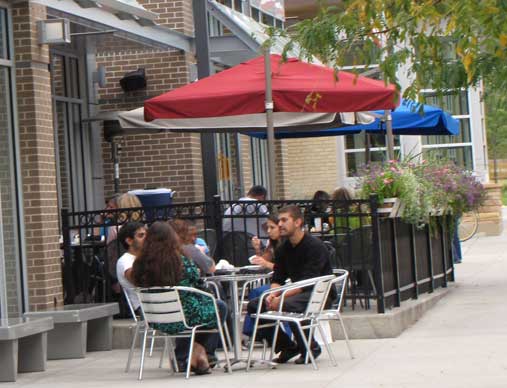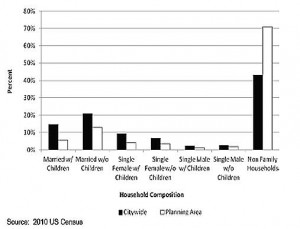
The average age in MIdtown is 32-33 years old. The population of Midtown consists primarily of non-family households with significantly fewer married couples compared to the rest of the city. Source: Midtown Plaza Area Plan Data Book, City of Kansas City.
As the city begins work on a new Midtown/Plaza area plan, it has put together a data book that gives a great overview of Midtown today. The city hopes to begin work on a new planning document that will guide future development of the area from 31st Street to 55th Street, The Paseo to State Line Road this fall. As part of that process, the city has developed a data book that offers the following insights:
Overview
The Midtown/Plaza area, which was incorporated into the City from 1897 to 1909, is within portions of the 3rd, 4th, and 5th Council Districts and is served by the Kansas City, Missouri School District. The area benefits from historic neighborhoods, a diverse population, the presence of large institutions, and a number of vibrant commercial districts. Major challenges include redevelopment pressures, crime, the status of the Kansas City School District, and the maintenance of public infrastructure.
The Midtown/Plaza area contains 25 neighborhoods and a number of important landmarks and districts including: Westport, the Country Club Plaza, the Nelson-Atkins Museum of Art, the 39th Street Commercial District, the Kauffman Foundation, the Anita B. Gorman Discovery Center, Loose Park, the University of Missouri-Kansas City, and Rockhurst University.
Population

The population of Midtown consists primarily of non-family households with significantly fewer married couples than the rest of the city. Source: Midtown/Plaza Area Plan Data Book, City of Kansas City.
The data book says that the population of the Midtown area saw a population loss of almost 50 percent between 1950 and 1990. Population growth slowed between 1970 and 2010. The data book says the population changes are based on the “outward migration of residents to suburban communities and the recent population growth north of the Missouri River.” The population of Midtown is expected to stabilize while the population of the city overall is expected to increase.

More Midtown residents use public transportation (6 percent) and bicycles (1.1 percent) than residents of the rest of the city. About 8 percent of Midtowners walk to work.
Household income: $35,528 (lower because households are smaller).
Crime: has decreased significantly.
Housing: multi-family housing is the prevailing type, with most of the city’s multi-family housing clustered here. Although 71 percent of the housing was built before 1970, it has held up well.
Education: more college degrees than the rest of the city overall.



Who’s talking